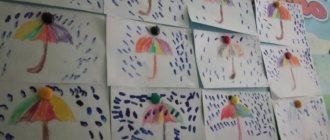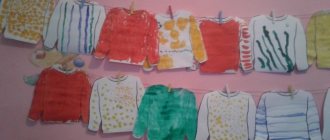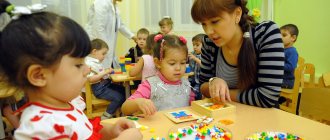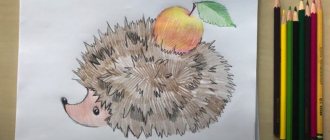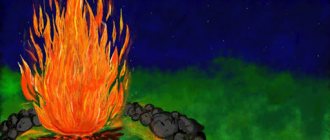Fine arts club program for the middle group
Dear friends, we are pleased to once again introduce you to Nina Vasilievna Lazurenko, a teacher at the Municipal Educational Institution “Primary School Implementing Adapted Educational Programs for Children with Visual Impairments, No. 2” in Volgograd, Volgograd Region. Today Nina Vasilyevna brings to your attention the program of the fine arts club in the middle group. The article will be of interest to preschool teachers.
A short commentary on the article from Nina Vasilievna:
“The program I have developed will help educators plan work on fine arts in educational activities.”
Creative reading...
Fine arts club program for the middle group
View article in full version
Preschool age is the foundation of a child’s overall development, the starting period of all high human principles. It is at this age that the foundations for the comprehensive, harmonious development of the child are laid.
The ability to be creative is a distinctive feature of man, thanks to which he can live in unity with nature, create without causing harm, multiply without destroying. Drawing is one of the most important means of understanding the world and developing knowledge of aesthetic education, since it is associated with the independent practical and creative activity of the child. In the process of drawing, a child’s observation and aesthetic perception, artistic taste and creative abilities are improved. By drawing, the child forms and develops certain abilities: visual assessment of shape, orientation in space, sense of color. Special skills and abilities are also developed: eye-hand coordination, hand control.
Systematic mastery of all necessary means and methods of activity provides children with the joy of creativity and their all-round development (aesthetic, intellectual, moral-labor, physical). And also, it allows you to fruitfully solve the problems of preparing children for school. The works of domestic and foreign specialists indicate that artistic and creative activity performs a therapeutic function, distracting children from sad, distressing events, grievances, relieving nervous tension and fears.
The lack of development of graphic skills and abilities prevents the child from expressing his plans in drawings, adequately depicting objects of the objective world, and complicates the development of cognition and aesthetic perception. Thus, the technique of depicting objects with thin lines is difficult for preschool children. The line carries a very specific artistic meaning and must be drawn quite professionally, which is not possible for children due to their age characteristics. Objects turn out to be unrecognizable and far from reality.
Fine art has a variety of materials and techniques. Often, familiar, traditional ways and means are not enough for a child to express his fantasies.
Decorative, or decorative - applied art is one of the types of artistic creativity. There is a wide range of topics, plots, works, artistic techniques used in the educational process:
- folk painting;
- national clothes;
- folk toy, etc.
The works of all these types of decorative and applied art are united by their main purpose: to serve as an artistic enrichment of the environment surrounding the child.
The purpose of the program: to introduce students to artistic culture; familiarization with decorative and applied arts, determining its significance in human life and society.
General tasks:
- enrich children's understanding of the world around them, including the world of art;
- increase speech motivation, develop speech, teach the organization of a coherent statement in the process of analyzing a work of decorative and applied art;
- develop the mental processes of the personality of pupils based on the material of classes;
- form and develop visual and graphic skills, solve motor skills problems;
- cultivate aesthetic taste and a creative attitude to life.
Objectives of the second year study group:
-help children create expressive images, maintaining the spontaneity and vividness of children's perception;
-promote the development of content, form, composition, enrichment of the color scheme of drawings;
-gradually, taking into account individual characteristics, increase the requirements for children’s visual and communication skills and abilities, without making them the subject of special educational knowledge;
- to contribute to the child’s feeling that the product of his activity - a drawing - is interesting to others (teacher, children, parents, kindergarten staff);
-develop speech based on lesson material. Teach to generalize and contrast, reason.
Classes within the framework of circle work most effectively develop graphic skills:
- maintaining the direction of movement;
- stopping movement at the desired point;
- regulation of pressure on a pencil, etc.
In the process of targeted training, shortcomings are overcome
motor skills. A variety of special exercises greatly
develop an eye. By practicing technical skills of various types of decorative and artistic creativity, students develop visual-motor coordination.
The program offers various forms of classes:
- individual and collective;
- organization of exhibitions;
- competitions;
- games - travel;
- excursions to museums and exhibitions of decorative and applied arts.
Understanding rhythm, harmony of color combinations, visual balance of shapes and colors is used in all classes.
Techniques and methods used in circle classes:
- Emotional mood - the use of musical works,
- Practical – exercises, game methods,
- Verbal methods - story, conversation, artistic expression, verbal techniques - explanation, clarification, evaluation.
- Visual methods and techniques - observations, examination, showing a sample, showing methods of implementation, etc.
Methods used:
- allow you to develop special skills that prepare the child’s hand for writing;
- make it possible to feel the multi-colored image of objects, which affects the completeness of perception of the surrounding world;
- form an emotionally positive attitude towards the drawing process itself;
- contribute to more effective development of imagination, perception and, as a result, cognitive abilities.
Expected results
Second year of study:
- ability to hatch and draw various lines with colored pencils;
- the ability to apply strokes of paint with a narrow and wide brush;
- the ability to recognize, name primary colors, shades of paint and mix them;
- ability to correctly use brushes, glue and plasticine in work;
- ability to use stencils and prints when working;
- Ability to clean up after oneself.
Forms for conducting the results of the implementation of the work program:
- Organizing monthly exhibitions of children's works for parents.
- Thematic exhibitions at the Moscow Educational Institution.
- Participation in city and exhibitions and competitions throughout the year.
- Creative report of the teacher - the leader of the circle.
- Design of an aesthetic development environment in the group.
